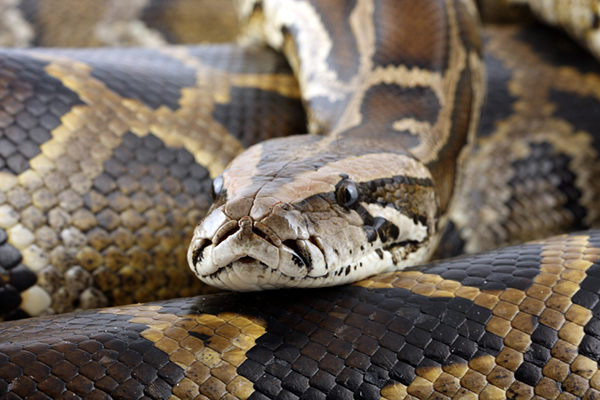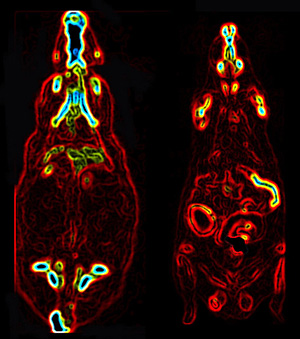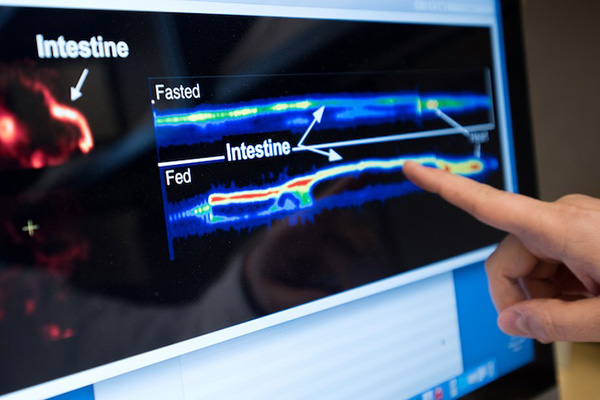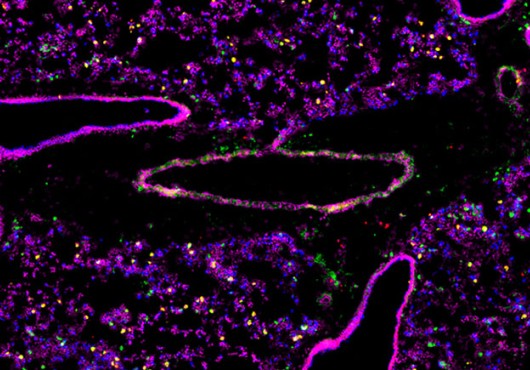
Originally from Southeast Asia, Burmese pythons are perhaps best known in the U.S. for the havoc they’ve been creating in the Everglades. Kept as pets and released into the wild, they can grow to nearly 20 feet long and are hunting animals such as marsh rabbits toward extinction—a problem Florida is trying to address with an annual Python Removal Competition.
But in the lab, at a diminutive 3 feet in length, Burmese pythons may have valuable lessons to teach about diabetes.
Extreme metabolism
Burmese pythons are capable of going four to six weeks between meals. When they do eat, their biology undergoes an extreme makeover. Cells in their gastrointestinal tract multiply rapidly, growing the intestine to six times its normal size within three days. Metabolism ramps up, boosting consumption of glucose and other fuels. Then everything goes back to baseline.
“What we’re saying is there might be a way to increase glucose disposal in the gut that may not be dependent on insulin.” - Nick Stylopoulos
This unusual metabolism is what interested endocrinology researcher Nick Stylopoulos, Harvard Medical School assistant professor of pediatrics at Boston Children’s Hospital. In 2013, he had published a highly reported diabetes study in Science. It showed, in a rat model, that bariatric surgery causes the small intestine to take up and burn blood sugar.

The unexpected sugar uptake is shown by this PET scan of the intestines. Note the increased yellow and orange in the rat on the right. It seemed to explain why type 2 diabetes rapidly resolves in people undergoing bariatric surgery for obesity, even before they lose much weight. The study also found increased levels of a glucose transporter molecule that draws sugar out of the blood.
Based on these findings, Stylopoulos proposed that it might be possible to lower blood sugar in people with diabetes by focusing on the intestine, an organ no one had thought of as a target in the past.
“It was a unique concept and people were questioning it,” said Stylopoulos. “People in the diabetes field focus on insulin secretion to control glucose levels and ways to increase insulin sensitivity. What we’re saying is there might be a way to increase glucose disposal in the gut that may not be dependent on insulin.”
Intestinal intrigue
It was clear to Stylopoulos that his lab needed to search for other models of intestinal fuel use. The effort was spearheaded by Eirini Nestoridi in his lab.
Looking at the scientific literature, they learned that Stephen Secor at the University of Alabama had done PET scans of Burmese pythons. Secor’s findings mirrored what Stylopoulos had seen with bariatric surgery in the rats: The snakes’ GI tracts seemed to light up with glucose markers after feeding.
“We have to study that,” Stylopoulos said.

The more Stylopoulos read up on Burmese pythons, the more he wanted to study them. In 1998, Secor and well-known scientist Jared Diamond described the animals’ unusual physiology in an article entitled, “A vertebrate model of extreme physiological regulation.”
Secor and Diamond noted that changes in metabolites and regulatory factors are much easier to track in Burmese pythons, thanks to their episodic feeding habits, than in people or other mammals that eat small, frequent meals. For this reason, they wrote, pythons are ideal for studying physiologic regulation, in much the way the unusually large axons of squid helped researchers study action potentials in the nervous system.
“It’s a rapid effect: You give food to a python, and the intestine lights up,” Stylopoulos said. “You naturally have this extreme physiologic response—you don’t have to do any manipulation.”
Fortuitously, Burmese pythons’ genomes had just been sequenced. A team led by researchers at the University of Colorado found “massive, rapid” changes in gene activity, including many genes influencing organ size and metabolism.
Setting up a python lab
Stylopoulos and colleagues have picked up where these studies left off. With the help of a pilot grant from Boston Children’s, they set out to establish a research program that will be one of just three in the U.S. to study Burmese pythons for medical reasons. (The others are in Alabama and Colorado.)
After clearing the project with state officials and finding special housing for the pythons, they needed to learn to work with them. Though the snakes are docile and friendly, even playful, their tendency to climb up peoples’ arms can be unnerving, and they do bite.
“For the inexperienced person, these are not animals that are easy to handle,” said Stylopoulos.
“Not many studies have looked at pythons at the molecular level.” - Nick Stylopoulos
He figured they’d seek training from experts in Alabama or the Everglades, but Arthur Nedder, a veterinarian with the animal research facility at Boston Children’s, offered his expertise.
“Arthur saw the project and said he was very excited about this, because he loves snakes,” said Stylopoulos. “He said that he’s super comfortable handling them and could help us and eventually teach us. This was so lucky.”
The initial studies, involving 10 pythons, will analyze gene expression in intestinal tissue before and after meals to see what new proteins are being made. The studies will also look for what triggers the abrupt change in the snakes’ physiology. The researchers suspect that it’s the mechanical forces placed on the intestinal wall by a large meal, but they’re also investigating whether one or more nutrients flip the switch.
“Not many studies have looked at pythons at the molecular level,” said Stylopoulos. “What will be interesting is the cascade of events after the initial trigger.”
The pythons may also help researchers understand growth signals in the intestines, which could help in treating short bowel syndrome. They may also shed light on how intestinal cells can proliferate so much without causing cancer.
“The more we work with these animals, the more we admire them and respect them,” said Stylopoulos. “I never thought my research would go in this direction, but they’re a fascinating model and may help us understand human diseases and define novel treatments.”
Adapted from a post on Vector, the research and clinical innovation blog at Boston Children’s.





